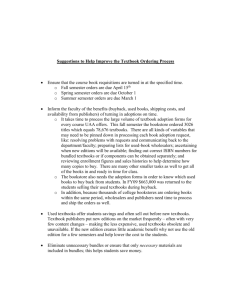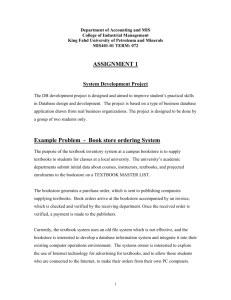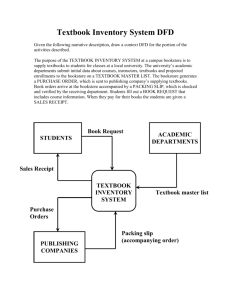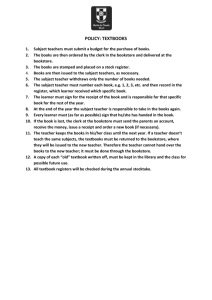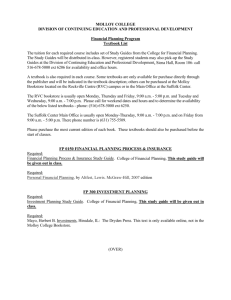USED TEXTBOOKS - Government Food Service
advertisement
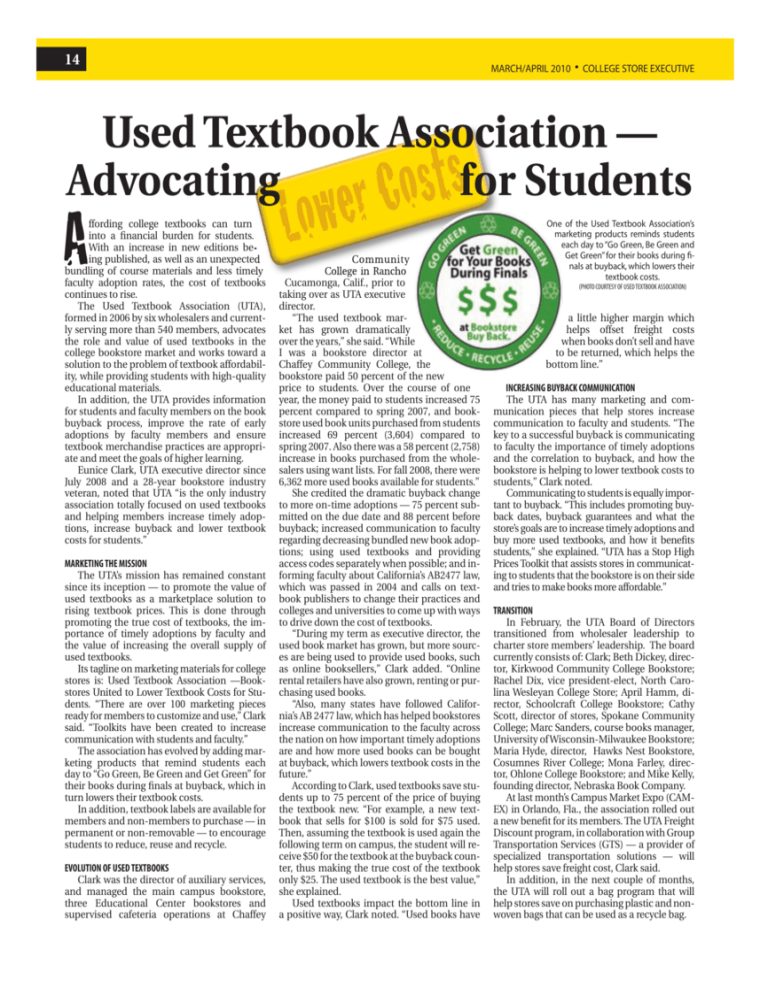
14 MARCH/APRIL 2010 • COLLEGE STORE EXECUTIVE Used Textbook Association — Advocating for Students A ffording college textbooks can turn into a financial burden for students. With an increase in new editions be-ing published, as well as an unexpected bundling of course materials and less timely faculty adoption rates, the cost of textbooks continues to rise. The Used Textbook Association (UTA), formed in 2006 by six wholesalers and currently serving more than 540 members, advocates the role and value of used textbooks in the college bookstore market and works toward a solution to the problem of textbook affordability, while providing students with high-quality educational materials. In addition, the UTA provides information for students and faculty members on the book buyback process, improve the rate of early adoptions by faculty members and ensure textbook merchandise practices are appropriate and meet the goals of higher learning. Eunice Clark, UTA executive director since July 2008 and a 28-year bookstore industry veteran, noted that UTA “is the only industry association totally focused on used textbooks and helping members increase timely adoptions, increase buyback and lower textbook costs for students.” Marketing the Mission The UTA’s mission has remained constant since its inception — to promote the value of used textbooks as a marketplace solution to rising textbook prices. This is done through promoting the true cost of textbooks, the importance of timely adoptions by faculty and the value of increasing the overall supply of used textbooks. Its tagline on marketing materials for college stores is: Used Textbook Association —Bookstores United to Lower Textbook Costs for Students. “There are over 100 marketing pieces ready for members to customize and use,” Clark said. “Toolkits have been created to increase communication with students and faculty.” The association has evolved by adding marketing products that remind students each day to “Go Green, Be Green and Get Green” for their books during finals at buyback, which in turn lowers their textbook costs. In addition, textbook labels are available for members and non-members to purchase — in permanent or non-removable — to encourage students to reduce, reuse and recycle. evolution of used textbooks Clark was the director of auxiliary services, and managed the main campus bookstore, three Educational Center bookstores and supervised cafeteria operations at Chaffey s t s o C r e Low Community College in Rancho Cucamonga, Calif., prior to taking over as UTA executive director. “The used textbook market has grown dramatically over the years,” she said. “While I was a bookstore director at Chaffey Community College, the bookstore paid 50 percent of the new price to students. Over the course of one year, the money paid to students increased 75 percent compared to spring 2007, and bookstore used book units purchased from students increased 69 percent (3,604) compared to spring 2007. Also there was a 58 percent (2,758) increase in books purchased from the wholesalers using want lists. For fall 2008, there were 6,362 more used books available for students.” She credited the dramatic buyback change to more on-time adoptions — 75 percent submitted on the due date and 88 percent before buyback; increased communication to faculty regarding decreasing bundled new book adoptions; using used textbooks and providing access codes separately when possible; and informing faculty about California’s AB2477 law, which was passed in 2004 and calls on textbook publishers to change their practices and colleges and universities to come up with ways to drive down the cost of textbooks. “During my term as executive director, the used book market has grown, but more sources are being used to provide used books, such as online booksellers,” Clark added. “Online rental retailers have also grown, renting or purchasing used books. “Also, many states have followed California’s AB 2477 law, which has helped bookstores increase communication to the faculty across the nation on how important timely adoptions are and how more used books can be bought at buyback, which lowers textbook costs in the future.” According to Clark, used textbooks save students up to 75 percent of the price of buying the textbook new. “For example, a new textbook that sells for $100 is sold for $75 used. Then, assuming the textbook is used again the following term on campus, the student will receive $50 for the textbook at the buyback counter, thus making the true cost of the textbook only $25. The used textbook is the best value,” she explained. Used textbooks impact the bottom line in a positive way, Clark noted. “Used books have One of the Used Textbook Association’s marketing products reminds students each day to “Go Green, Be Green and Get Green” for their books during finals at buyback, which lowers their textbook costs. (PHOTO COURTESY OF USED TEXTBOOK ASSOCIATION) a little higher margin which helps offset freight costs when books don’t sell and have to be returned, which helps the bottom line.” increasing buyback coMMunication The UTA has many marketing and communication pieces that help stores increase communication to faculty and students. “The key to a successful buyback is communicating to faculty the importance of timely adoptions and the correlation to buyback, and how the bookstore is helping to lower textbook costs to students,” Clark noted. Communicating to students is equally important to buyback. “This includes promoting buyback dates, buyback guarantees and what the store’s goals are to increase timely adoptions and buy more used textbooks, and how it benefits students,” she explained. “UTA has a Stop High Prices Toolkit that assists stores in communicating to students that the bookstore is on their side and tries to make books more affordable.” transition In February, the UTA Board of Directors transitioned from wholesaler leadership to charter store members’ leadership. The board currently consists of: Clark; Beth Dickey, director, Kirkwood Community College Bookstore; Rachel Dix, vice president-elect, North Carolina Wesleyan College Store; April Hamm, director, Schoolcraft College Bookstore; Cathy Scott, director of stores, Spokane Community College; Marc Sanders, course books manager, University of Wisconsin-Milwaukee Bookstore; Maria Hyde, director, Hawks Nest Bookstore, Cosumnes River College; Mona Farley, director, Ohlone College Bookstore; and Mike Kelly, founding director, Nebraska Book Company. At last month’s Campus Market Expo (CAMEX) in Orlando, Fla., the association rolled out a new benefit for its members. The UTA Freight Discount program, in collaboration with Group Transportation Services (GTS) — a provider of specialized transportation solutions — will help stores save freight cost, Clark said. In addition, in the next couple of months, the UTA will roll out a bag program that will help stores save on purchasing plastic and nonwoven bags that can be used as a recycle bag. CSE0410 BookByte.indd 1 3/5/10 10:12 AM COLLEGE STORE EXECUTIVE • 15 MARCH/APRIL 2010 Promoting Price Savings A ccording to Kelly Gray, general manager, Ned’s Berkeley Bookstore, University of California, Berkeley, a majority of students want to shop for used textbooks, and their demands are simple. “Quality and quantity of used textbooks to choose from,” she said. “The availability of such affects the students’ viewpoint of us and their buying decision.” Besides being good for the environment to purchase a used book, it’s also good for their pocketbook, Gray explained. “Students can save 25 percent off the new price by purchasing a previously used book. And with the added incentive of returning that book by reselling it to us during buyback, they can see up to an additional 60 percent back.” Ned’s Berkeley Bookstore utilizes various advertising strategies to promote the price savings used books represent for students. “We utilize the most typical of advertisement strategies of passing out flyers and coupons, posting advertisements in the local papers, Facebook and ads on buses that most students typically use to and from campus,” Gray noted. “In addition to outside store advertisements, in-store savings are listed on bookshelf tags, with the new price listed next to the used price and signage to draw attention to the ‘deal busters,’ so to speak.” Marketing the store’s buyback process is essential for students and faculty, and the store itself. “Advertising and more advertising, via coupons, newspapers and bus routes, as well as using social networking sites such as Facebook,” she pointed out. “In addition, our staff lets potential mid-semester buyback customers know the premium time to sell and why. Honesty with students increases customer satisfaction, and they inform friends and classmates when they should come back to get the most for their books.” Among the marketing techniques that Gray’s store implemented recently to promote the purchase of used textbooks is the introduction of reusable Ned’s bags, which, when brought in with each transaction, saves the student 5 percent off each used book, as well as a Ned’s card that allows 10 percent off used books. Gray’s store has several keys to running a successful book buyback, increase early faculty adoptions and increase the supply of used textbooks. Ned’s Berkeley Bookstore held a promotion during fall 2009 buyback, in which students could win an iPhone or other prizes when they sold back their books at the store. (PHOTO COURTESY OF NED’S BERKELEY BOOKSTORE) “For our buyback we have been in the habit of giveaways,” she explained. “‘Schwag,’ goodies, freebies, what have you, we offer it during every buyback rush in themes to reward and lure in students, faculty and general community members who are passing by or have heard of our promotion through word of mouth. “Besides offering more than any other bookstore in the area in terms of percentage, we also do promos varying from extra cash, discounts on future purchases, food, candy and random assortments of gifts donated by ourselves and other vendors in the community. For customer convenience, we also set up remote buyback locations so students don’t have to trek across campus to sell back their books.” Early adoptions are what Gray calls “almost pure finger work, with e-mail and virtual flyers sent out to professors and department heads, requesting various adoptions and stressing the vital importance early adoptions are in acquiring stock. “With the size of our campus and the constant new flux of staff, it’s important to alert professors that it isn’t magic that summons their books to our shelves, and to ensure problems are taken care of well before the semester starts is only obtained by turning book orders in several weeks in advance.” In the end, Gray said that a successful buyback season is dependent upon successfully acquiring, at least almost, all book orders for the upcoming semester(s). Textbook rentals have recently become a very popular option for students to purchase “those bulky expensive textbooks they really only plan on using for one semester,” Gray said. “Ned’s realizes this and has actually initiated a rental program. Rentals are great for students in that they save them 50 percent off the new price of a book, and since the students bring them back to us at the end of the semester, this also guarantees that we will have affordable copies for future students.” —CSE CSE0410 NebraskaBook.indd 1 2/19/10 11:43 AM
